Iz Man Interferes With Airplanes With Laser, Faces up to 5 Years in Prison
December 4, 2022 - The police officers from the Zadar Police Station have completed a criminal investigation of a 55-year-old Croatian citizen for a crime against public safety. This man from the island of Iz used a laser to interfere with airplanes flying over the island.
As Index writes, it is suspected that on November 30, 2022, around 8:20 p.m. in the Zadar area, he intentionally interfered with the flight of an airplane operated by a 35-year-old pilot using a laser, and with such a dangerous act seriously endangered the safety of the airplane flight and caused danger to people and property, announced PU Zadar.
He faces up to five years in prison.
After a criminal investigation, a criminal complaint was filed against a 55-year-old Croatian citizen at the competent state attorney's office in Zadar on suspicion of having committed the criminal offense of "endangering life and property by means of a generally dangerous act or means."
Yesterday he was taken to the custody unit of the Zadar Police Department. Pursuant to the provisions of Art. 215 of the Criminal Code of the Republic of Croatia, according to which a prison sentence of six months to five years is foreseen for the perpetrators of this criminal act.
As further reported by Index, last year, Govorčin did the same, admitting at the time that it was "self-defense" because the islanders constantly suffer from the shaking, noise, and terrible thunder of the planes that fly over the island.
"It was pure self-defense. Last time, because of the noise and the terrible thunder of the planes that flew over the place, almost everyone fell from the olive trees during harvest, and there were mostly elderly people living in the town. It's like that every day," he said then after having interfered with the flight of an airplane in the Zadar area with a laser on two occasions, once in June and once in September.
For more, make sure to check out our dedicated Lifestyle section.
The Guardian Ranks Lastovo Among Europe's Most Enchanted Islands
June the 25th, 2022 - The British publication The Guardian has made no efforts to hide its love for Croatia over the years, with destinations up and down the country making it to various lists. It has now published a list of the most enchanted, off-the-radar European islands, and the gorgeous southern Dalmatian island of Lastovo is quite rightly on it.
As Morski writes, The Guardian has included beautiful Lastovo on its recently published list of the ten most enchanted, off-the-radar European islands boasting untouched nature, which still aren't as attractive to tourists as other more popular ones might be. A trip from Split to Lastovo takes just under five hours, which is why tourists don't tend to be in any particular rush to arrive at this beautiful haven north of Dubrovnik.
Croatia's islands are no strangers to such lists, and Lastovo certainly deserves special recognition for the incredible combination of pristine vegetation and nature and stunning bays in which a refreshing dip results in a feeling of pure nirvana.
''It may take an arduous four-and-a-quarter hour ferry crossing from Split to reach Lastovo, but this chunky Croatian island is so different from its touristy sister, you’ll be glad you made the effort. Spend your time dawdling through pine forests, admiring the island’s Venetian-style houses, then exploring some of its 38 churches or swimming in the transparent waters off Skrivena Luka Bay. There’s just one hotel – the aptly named Solitudo, whose sea-facing restaurant serves up delicious Dalmatian-style spiny lobster.'' writes The Guardian in its description of this alluring island.
In addition to Lastovo, The Guardian's list also includes the island of Porquerolles in France, Tabarca in Spain, Bozcaada in Turkey, La Graciosa in Spain, Syros in Greece, Cabrera in Spain, Tinos in Greece, Île de Batz in France and Filicudi in Sicily.
For more on Croatian islands, make sure to check out our dedicated travel section.
15.8 Million Kuna Secured for Croatian Island Drinking Water Supply in 2022
March the 8th, 2022 - 15.8 million kuna has been secured for the provision of clean and safe Croatian island drinking water for this year, which is excellent news for the country's many island residents.
As Morski writes, even though Croatian islanders are still very much playing catchup with the mainland in multiple ways, there's been a bit of good news when it comes to Croatian island drinking water. This year, the government plans to co-finance the water supply service to the country's many inhabited islands in the amount of almost 16 million kuna.
These funds are intended for islands that aren't connected to the country's public water supply system, and that drinking water will be delivered by water carriers and/or tankers at a subsidised price, the Ministry of Regional Development and European Union (EU) Funds recently announced.
Unfortunately, we are witnessing more frequent and longer droughts as climate change continues to alter the weather and temperature patterns we'd come to know so well, and the need for water is especially increased during the boiling hot and often harsh summer months. Due to the reduction in overall rainfall, many of the country's islands are unable to collect anywhere near enough rainwater, meaning that the drinking water supply through aquifers and cisterns is currently the only alternative.
Figures on this topic show that about 4,860 households on 20 islands are not connected to the public water supply network, nor do they have a network, and they also aren't even connected to reliable sources or a water supply. Whether this problem will persist and how it will be solved in the near future is still unknown.
For the implementation of the Croatian island drinking water measure for the year 2022, the Ministry of Regional Development and European Union Funds has secured and will provide funds in the exact amount of 15.8 million kuna.
For more on Croatian islands, make sure to follow our dedicated lifestyle section.
5 Ways to Get a Free Week’s Stay in Croatia's Dream Destinations
February 24th, 2022 - If you happen to love spending time outdoors and have a few days to spare this spring or summer, Croatia’s national and nature parks offer amazing volunteering opportunities that involve a free week’s stay in some of the most spectacular locations in the country
We prepared a selection of five attractive volunteer programmes that are 5-10 days long and require up to 6 hours of work a day, with free accommodation, meals and transportation provided to participants. English speakers are encouraged to apply, as knowledge of Croatian isn’t a requirement for any of the following roles:
1. Dry Stone Restorer in Mljet National Park
Become a guardian of the past by restoring ancient dry stone walls in Mljet National Park. Traditional dry stone construction is inscribed in the list of intangible cultural assets of the Republic of Croatia, which means you’d literally help restore and preserve precious cultural heritage on Mljet island!
Volunteers will learn how to build and fix up walls, stairways and other dry stone structures. The job also involves clearing existing dry stone structures of vegetation, simple processing of stone using hand tools, and photographing dry stone walls before and after restoration.
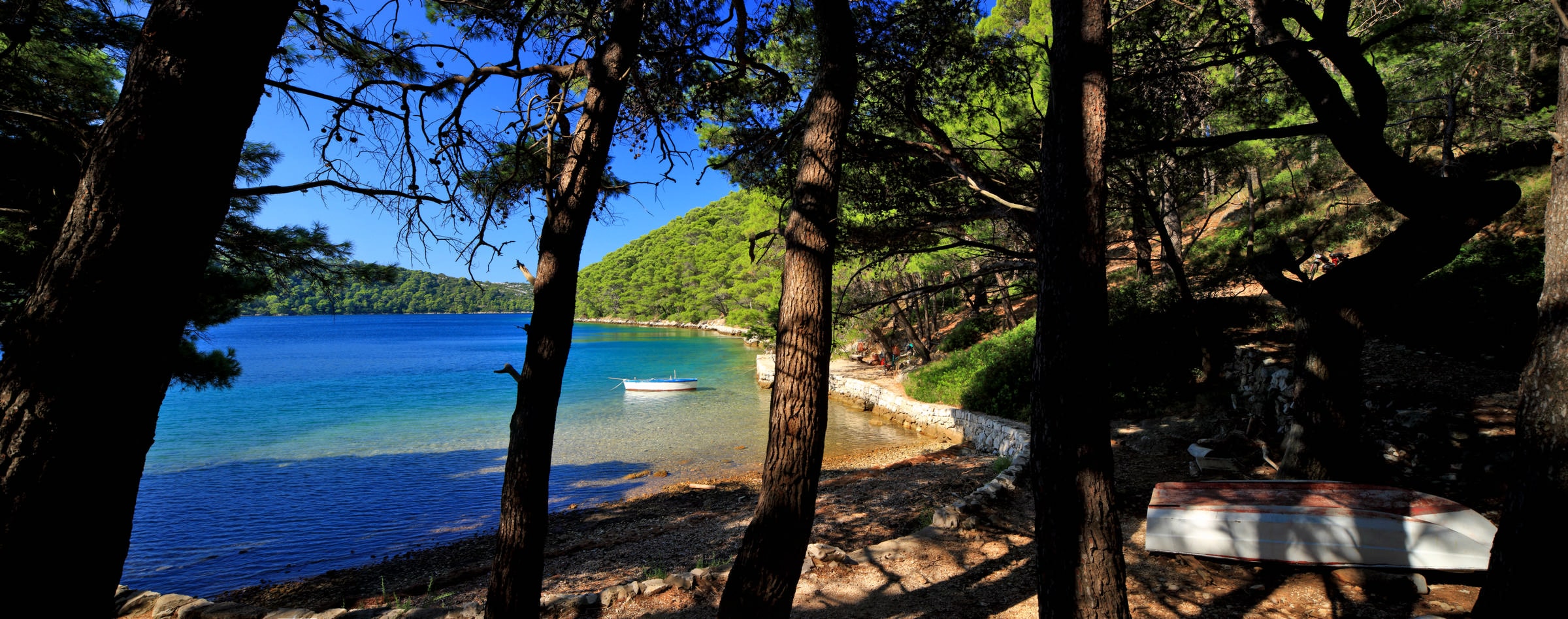 Mljet island / Photo © Mario Romulic
Mljet island / Photo © Mario Romulic
The programme takes place in April and is seven days long, including six days of work and one day off. Volunteers are expected to work six hours a day with a one-hour break, but considering that the physical work involved in this particular programme can be strenuous, the number or working hours can be reduced if needed.
All necessary tools will be provided by the Park. Accommodation is provided free of charge on Mljet island in the Collier building owned by the Park, which has seven rooms equipped with bunk beds, toilets, showers, a kitchen and a living room. Meals are also provided free of charge, with the Park delivering groceries to volunteers or providing free meals at the local hotel.
If stonemasonry isn’t your cup of tea and you’d prefer a less hands-on kind of creative work, may we suggest another volunteer programme on Mljet island:
2. Photo Amateur in Mljet National Park
A dream come true for anyone who loves island hopping and snapping pics of stunning landscapes (don’t we all?), this programme involves photographing the scenery and events in Mljet National Park in the period between April and June.
Depending on the time of year, volunteers will be required to photograph various locations, events and activities on Mljet island using their own gear. You’ll be capturing the island’s flora and fauna, cultural monuments and landmarks, historic sites, enchanting landscapes and fun summer events.
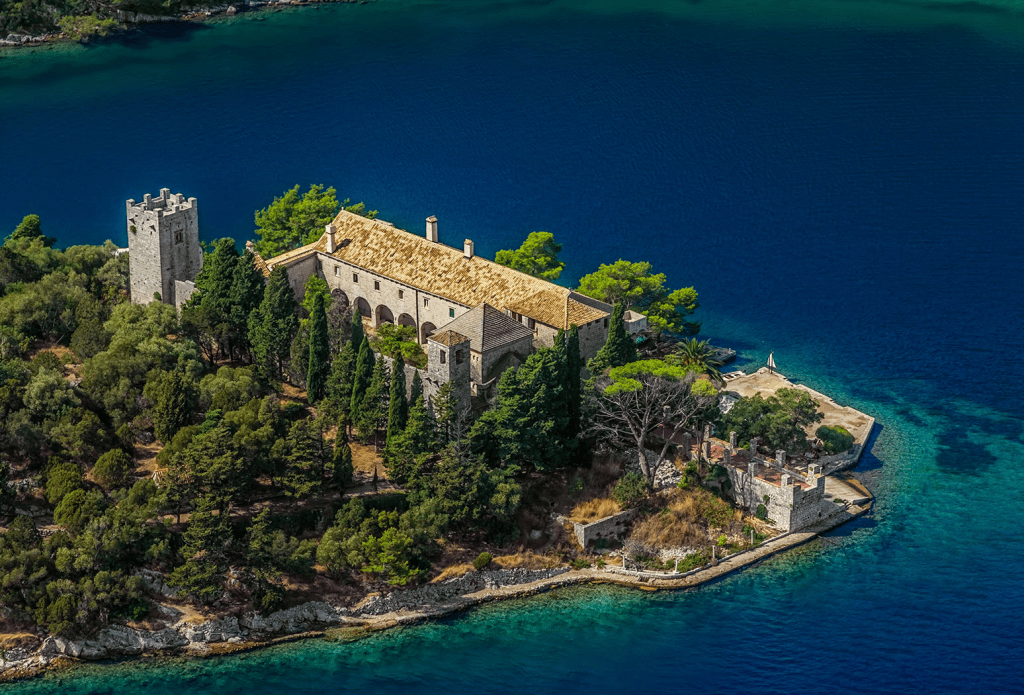 Mljet National Park / Photo: volonteri.parkovihrvatske.hr
Mljet National Park / Photo: volonteri.parkovihrvatske.hr
Those who choose to participate in this particular programme will sign a statement of the assignment of the photos to Mljet National Park. You’ll have to submit the photos shortly after the programme is over, and can look forward to seeing them featured in the Park’s publications in Croatia and abroad.
A minimum of one DSLR camera with a lens is required to partake in this programme.
You’ll have plenty of time to explore the island on your own time, and there’s no shortage of things to do: there are over 40 kilometres of hiking and cycling trails, you can rent a kayak or canoe to explore the saltwater lakes on Mljet, or take diving lessons with a certified instructor.
For all Mljet-based programmes, volunteers are to bear the cost of travel to Mljet island, and the Park will provide transport from the ferry port on Mljet to the place of accommodation.
3. Gull Catcher in Kornati National Park
Are you a fan of the great outdoors and love being in close contact with wildlife? Consider becoming a seagull catcher in Kornati National Park. Don't worry, you'll be releasing them too!
You’ll be joining the Park’s experts as they band and monitor Caspian gulls in the stunning Kornati archipelago, specifically on a few islands where seagulls are known to nest.
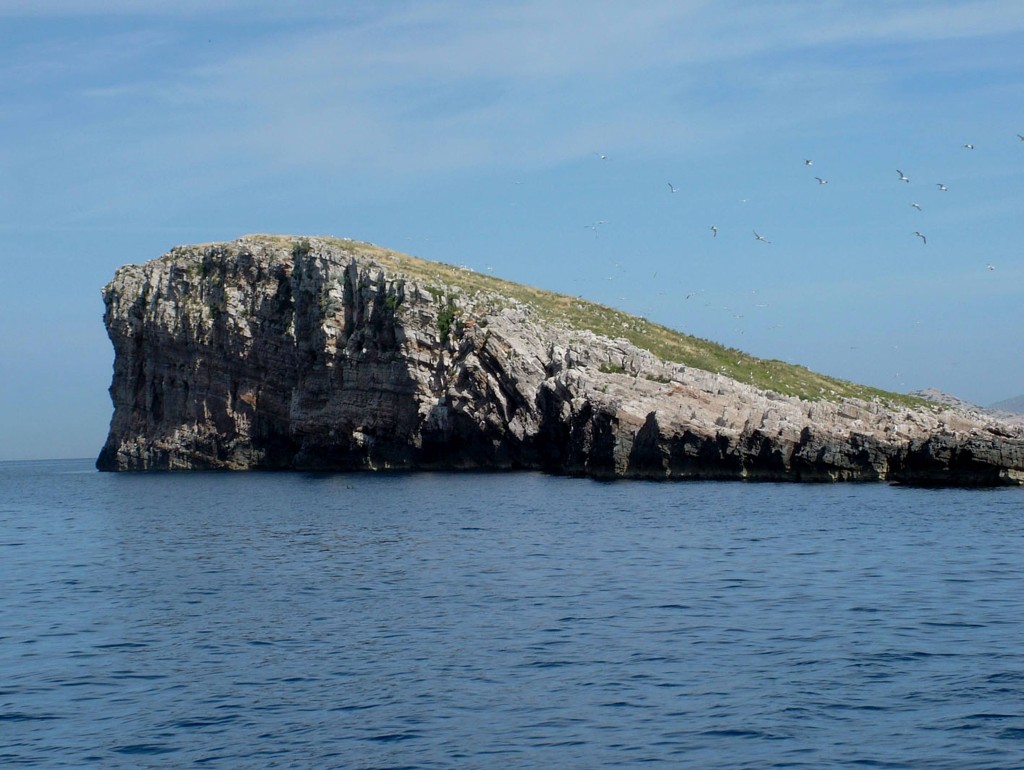 Kornati National Park / Photo: volonteri.parkovihrvatske.hr
Kornati National Park / Photo: volonteri.parkovihrvatske.hr
Do you dare to catch a young gull with your bare hands? If you do, you get to name the bird and take notes as it gets banded by a qualified employee of the Park. Banding and monitoring allows experts to track the behaviour and habitats of seagulls in order to collect data used to ensure protection of the species.
Volunteers will receive training prior to starting work and will be supervised by the Park staff. The programme takes place in May and June lasts about ten days, with volunteers expected to work seven hours a day.
Accommodation is provided and free, and in this case, it’s pretty amazing: you’ll be staying on a sailboat owned by the National Park Kornati, fully furnished and featuring 3 cabins, 6 beds, a living room, kitchen and toilet.
 Kornati National Park / Photo © Mario Romulic
Kornati National Park / Photo © Mario Romulic
Groceries are provided free of charge, and volunteers can either prepare meals on their own or seek the help of the volunteer manager.
Volunteers have to arrange transportation to Murter island, while further transport from Murter and within the Park area is organised by the Park and free of charge.
4. Traditional Gardener in Lonjsko Polje Nature Park
Lonjsko Polje (Lonja Field) is the largest protected wetland in Croatia, located approximately 70 km south-east of Zagreb.
If you have a green thumb and don’t mind getting your hands dirty, you’d be a great fit for a traditional gardener in Lonjsko Polje Nature Park. You’d help clean up the untended plots in the Park and plant new seedlings around traditional wooden houses in the villages of Krapje and Čigoč - think of it as traditional landscape design!
 Lonjsko Polje Nature Park / Photo © Mario Romulic
Lonjsko Polje Nature Park / Photo © Mario Romulic
The programme takes place in April and lasts five days, six hours of work each.
Accommodation is provided free of charge in a dormitory in Krapje. The facility is equipped with a small kitchen and a bathroom, and has central heating. As volunteers will be sleeping on spare beds, they are required to bring their own sleeping bags. Groceries are provided free of charge, and bikes and vehicles are available to use for transportation within the Park.
5. Guardian of Plant Biodiversity in Brijuni National Park
There’s not much need for gardening on Brijuni islands - domestic wildlife and imported species such as mountain zebras and mouflons take care of landscaping by nibbling away at the grass at all times.
There’s a single item on the menu that the animals don’t like: a spiky flower called Spanish oyster thistle. Since the wildlife practically mows the lawn, it removes all natural obstacles that would prevent the spread of the Spanish oyster thistle, allowing it to take over whole areas that would otherwise be home to other plants.
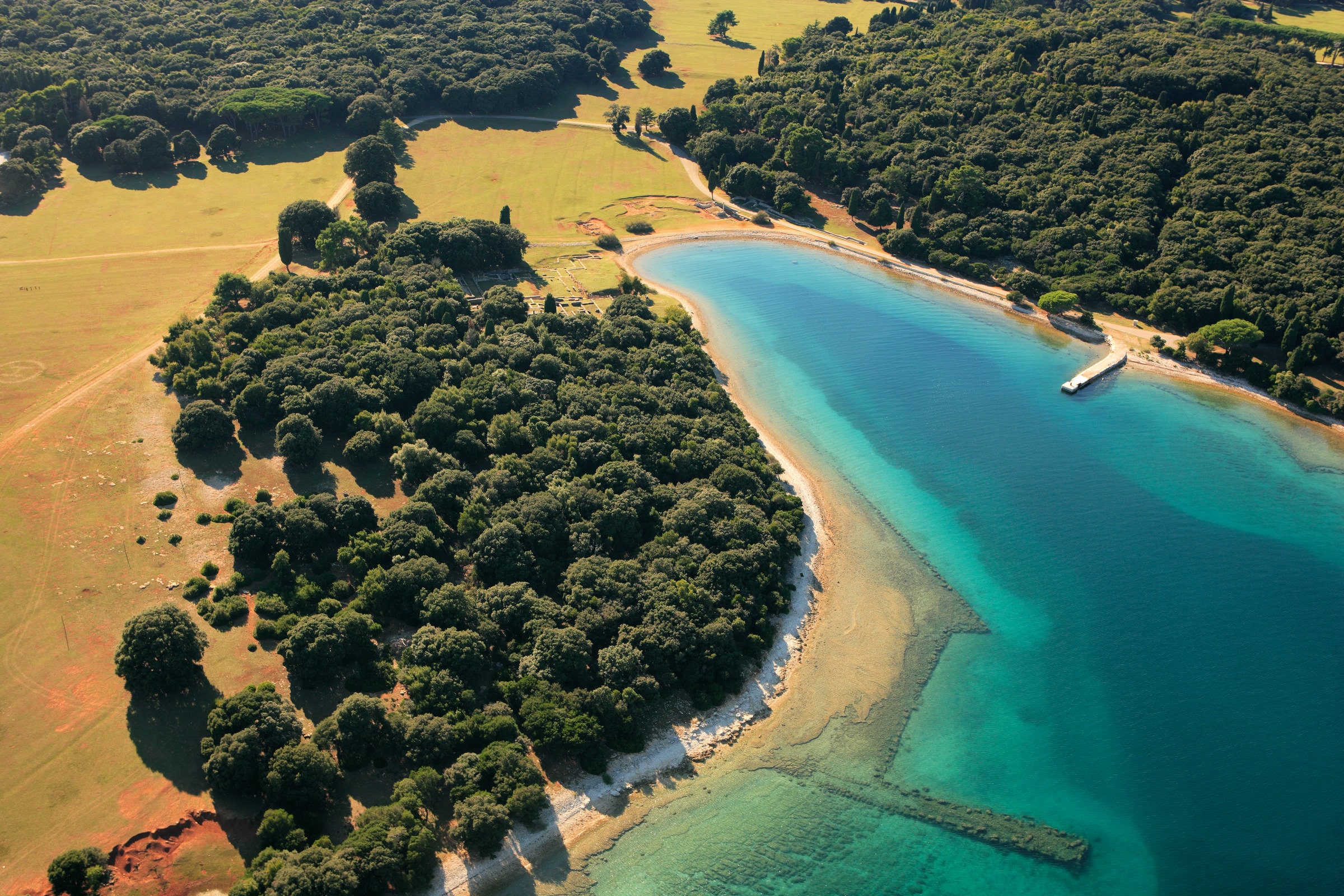 Brijuni islands / Photo © Mario Romulic
Brijuni islands / Photo © Mario Romulic
As a volunteer, you’ll help maintain the biodiversity on the meadows of Veliki Brijun island by keeping the pesky thistle in check. You’ll be removing the aggressive plant using provided gardening tools.
Volunteers are needed in the month of May and are required to put in 6 hours of work daily. Beyond that, the islands are yours to enjoy: explore the Safari and Ethno Parks, rent golf equipment and play on the golf course opened in 1922, or go for a swim at one of Brijuni’s pristine beaches.
The Brijuni are also a nice jumping off point for trips in Istria. Discover the ancient Roman monuments in Pula which is located only 7km away from Fažana, or visit the picture-perfect city of Rovinj.
 Wildlife on Brijuni islands / Photo © Mario Romulic
Wildlife on Brijuni islands / Photo © Mario Romulic
Accommodation is provided in one of the apartment buildings on Veliki Brijun island that are owned by the Park. Apartments are equipped with toilets, bathrooms, and a kitchen; rooms are shared with one or two other volunteers.
Groceries are provided free of charge and delivered to the apartment building, and one meal a day is also provided free of charge in the workers’ restaurant.
Volunteers have to arrange transport to Fažana town, and boat transportation to and from Veliki Brijun island is organised by the Park free of charge for the duration of the volunteer programme.
***
Applicants who don’t speak Croatian must be able to speak English in order to communicate with the park authorities and volunteer coordinators.
You can find more information about these and other volunteer programmes on the website Volunteer in Parks of Croatia.
Looking to apply? Fill out this form (in English), pick a programme you like and specify when you're free to participate, and the relevant programme coordinators will get back to you.
Please note that some of the programmes might not be accepting applications for the time being, or might be otherwise affected by epidemiological measures.
Check out our comprehensive Guide to the Nature and National Parks of Croatia.
How Much for a Cold Drink on Krk Island? Just Give Baba a Kiss
An ancient custom on Krk island involves planting a kiss on a wet rock on the side of the road. Looking into the curious ethnological phenomenon on February 1, 2022
Many holidaymakers have discovered the charms of Baška, a picture-perfect town on Krk island. There’s plenty for this dreamy destination to boast, including a 1800m long pebble beach ideal for those who love to soak up the sun, and adventure trails for visitors who prefer an active vacation.
Visiting Baška wasn’t such a simple feat back in the day, judging by an ethnological phenomenon described by Alan Žic-Teklin of KrkDiscovered. When arriving in Baška for the first time, one was obliged to kiss a wet old woman on the way to town. No, this doesn't sound any more enticing nor any less wrong in Croatian: poljubiti mokru babu.
(Baba stands for old woman, crone or grandma, depending on the context. In this scenario, it falls somewhere between the first two, but we’ll go with the more respectful option to avoid upsetting any ancient spirits. You never know.)
Thankfully, this particular baba was simply a common nickname for stone monoliths scattered over the island. Always located in damp spots near water springs - hence the wet part of the name - the rocks were referred to as babe and the custom dictated to give them a kiss when passing by.
Where did this come from? Legend has it that St Jerome (4th century AD) was visiting the bishop of Krk and got thirsty while traversing the island. He hit a rock with his staff, causing water to spring from stone.
Since one would have to lean close to the rock and press their lips against the surface to get a drink of water, this would have resembled kissing the rock, and so the saying was born.
Legends aside, the local custom of kissing the stone baba has long been a subject of interest of historians and ethnologists. Jelka Vince-Pallua, PhD proposed a theory that the custom originates from ancient fertility cults that were practised before the monoliths, while ethnologist Nikola Bonifačić-Rožin considers that the ‘old women’ stem from an ancient superstition that the rocks will prevent the floods from washing away precious fertile soil.
The best known baba on Krk island used to be located on the side of the road at the locality Žanac near Baška. The ancient rock isn’t there anymore and has been replaced with another one, but to keep up with tradition a pipe has been installed on the location, allowing passersby to get a drink of cold water.
And the new rock that stands in place of the old monolith? It’s part of the Baška Glagolitic Alphabet Trail, a series of 35 stone sculptures displayed on a trail meandering through the Baška Valley, each bearing a different letter of the Glagolitic alphabet.
Glagolitic letters Ž and E are carved into this particular stone, standing for Žanac est! Loosely translated, it means ‘Here is the Žanac spring!’ pointing to the wealth of water resources in the area. As early as the Stone age, people inhabiting Krk island first settled in Baška Valley precisely for its many water springs.
Even though it’s not the original baba, the sculpture allows travellers in passing to respect the ancient custom and give baba a peck on the cheek if they so decide. Don’t find the prospect that enticing? You can simply mark the sculpture on your Glagolitic Trail guide - every monument has a small plaque with raised letters you can copy into the blank pages in the guide. (Copy them all as proof you visited all the locations on the trail, and you get a little gift.)
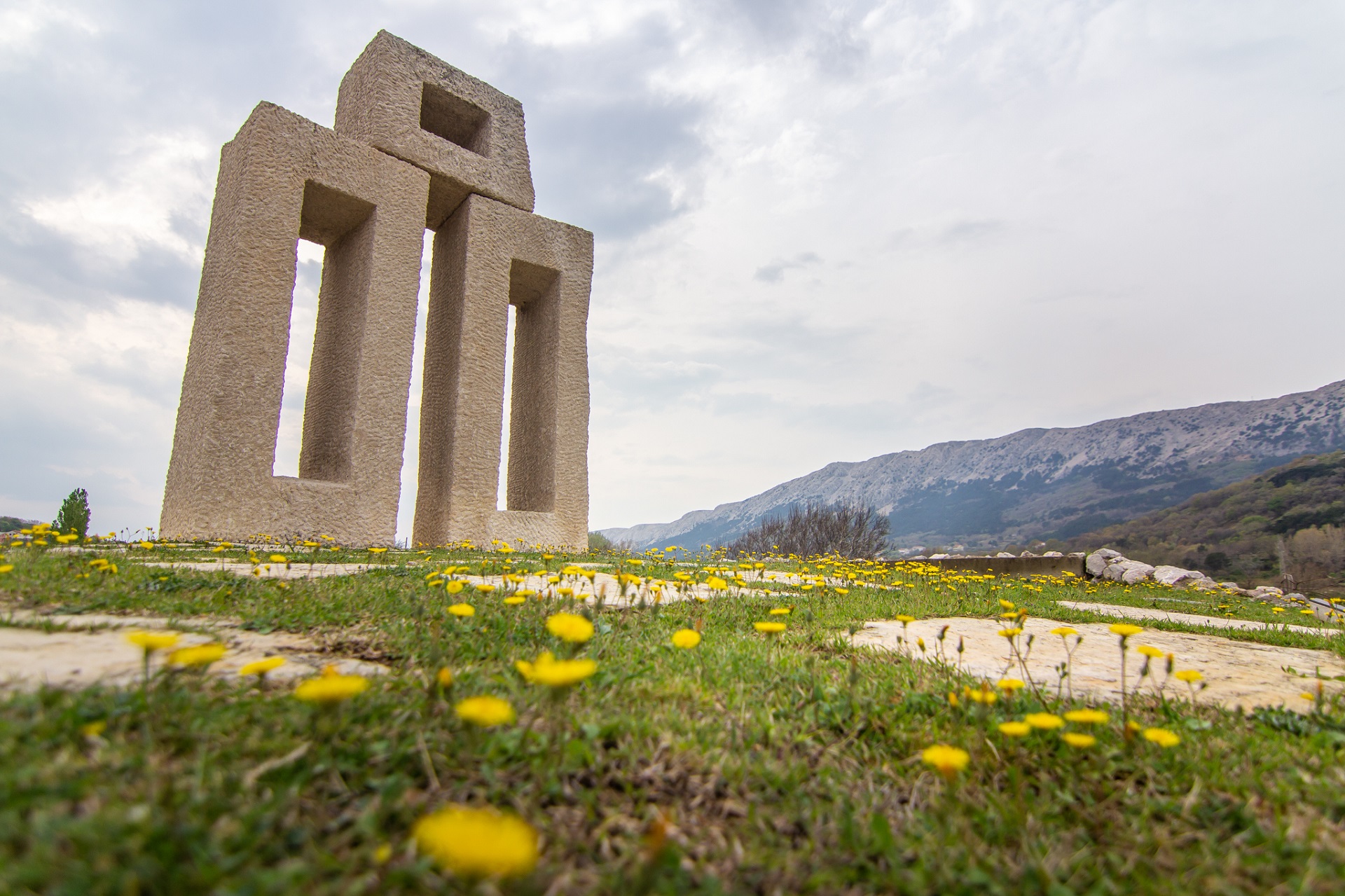
The letter L, sculpture by Ljubo de Karina / visitbaska.hr
The Glagolitic Trail project was devised by the Sinjali Association for culture, tradition and ecology from Krk. Each sculpture was sponsored by a different town; four were created by the renowned Croatian sculptor Ljubo de Karina, the rest were made by fifteen art academy students from Croatia, Slovenia, Austria and the Czech Republic.
The trail was created to highlight the rich cultural heritage of Krk island and to serve as a reminder of the importance of the Glagolitic alphabet in Croatian history. The Baška tablet in particular - perhaps the most distinguished attraction in Baška, at least where Croatian culture and history are considered.
Discovered in the church of St Lucy in Jurandvor and dating to 1100, the limestone tablet is a legal document bearing an inscription where the Croatian name (hrvatski) is mentioned in writing for the first time in history, in Glagolitic script.
You can learn more about the Baška Glagolitic Trail in this pdf guide, and follow Krk Discovered on Facebook.
Over €1Bn To Be Set Aside for Development of Islands Until 2027
ZAGREB, 20 Aug, 2021 - EU Funds and Regional Development Minister Nataša Tramišak said on Friday in Split that HRK 7.8 billion would be earmarked for development projects on Croatian islands until 2027.
The national plan for the development of islands will provide a scope for investments, and we have assessed that 7.8 billion kuna will be necessary for the implementation of measures envisaged by the plan. However, that amount is not definite and other ministries are expected to make contributions to additional investments in compliance with the money made available in EU funds until 2027, Minister Tramišak told the press.
Tramišak held the news conference after she awarded seven contracts, worth HRK 22 million in total, on regulating the state's co-funding of the EU-funded projects.
The total value of those seven projects which will be implemented in Split-Dalmatia County stands at 223 million kuna, and 140 million will be covered by EU funding.
After Split, Tramišak travelled to Hvar for a ceremony of awarding HRK 4 million worth of contracts on that island.
The registry of islands and the national island development plan will be presented at that ceremony.
More than six billion kuna was invested from national funds into different activities and projects for the islands in the 2016-2020 period.
Croatia has 1,244 islands, and 45 islands are permanently or temporarily inhabited, with 51 maritime routes, 58 community health centres, 102 primary and 13 high schools, and 23 care homes.
(€ 1 = HRK 7.482172)
For more on business, follow TCN's dedicated page.
For more about Croatia, CLICK HERE.
A Trip on Solta Island: 6 Lessons I Learned from Locals
May 24, 2021 - A TCN intern takes a trip on Solta Island without preparation, encounters unusual experiences with the locals, and learns lessons that will be helpful for anybody visiting the closest island to Split.
1. Clothes do not make the man. A port does not make the island. Don't be too quick to judge.
Rogac port where the ferry from Split comes does not impress a traveller. Like most people, I had visited the more popular island of Brac before I went to Solta. Rogac loses out to shiny Supetar, the biggest city on Brac. The port of Rogac is tiny, there is nothing to do there, no people. However, exactly here in Rogac, the first strange story happened to me in the first hour after my arrival. I found one good angle between the yachts at the marina and sat down to take an on-arrival picture. Then someone called out to me...
"Do you know what this is in front of you?" a senior man asked me.
"No, I don't," I said. "I know what is a boat, a yacht, a ship, and this vessel is somewhere between a boat and a yacht, closer to a boat, of course, but what exactly it is, I've no idea," I thought.
"Are you a journalist?"
"No, I'm just a tourist. I came here for the weekend. I'm from Russia but currently work in Split."
"What do you think about your president?"
The question put me in an awkward position. This grandpa in a baseball cap with a canister in his hand, similar to a grandpa from 'Gravity Falls', looked nice. The matter was tricky. What's his opinion? What if our minds are the opposite? I did not want to argue with him. Senior people rarely change their minds, thus even my MD in political science wouldn't help me.
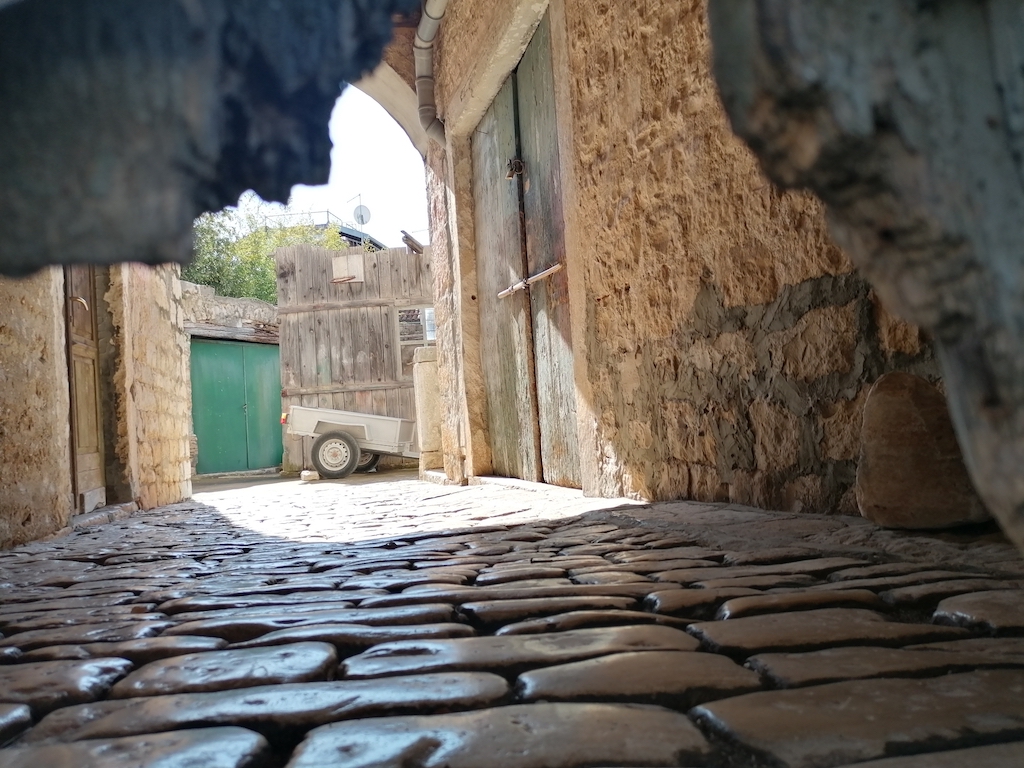
"It's hard to answer in one sentence about his 18 years of the presidency," I started to draw back the fire. Milan, that's his name, interrupted me. He told me that our president is a strong person he'd like to have as a major somewhere in Dalmatia. He said that he'd like to get vaccinated with the 'Sputnik V' vaccine. I guess that these statements should be regarded as a gesture of goodwill to me in any case.
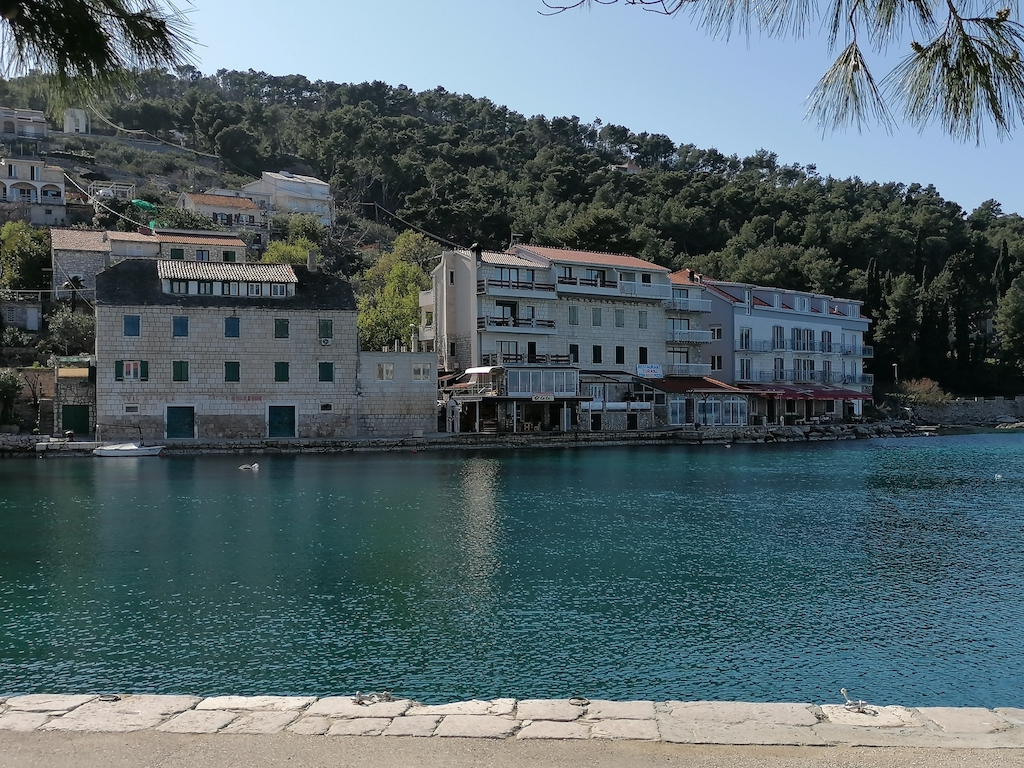
Actually, Milan knows about Russian-Croatian relations much more than the average person. He knows admiral Mate Zmayevic (born in the city of Perast, Dalmatia) who fought for Peter I in the Northern War, Alex Dundic (born in the village of Grabovac, Dalmatia) who fought for the Red Army in the Russian Civil War. He listens to Russian opera stars Elina Garancha, Anna Netrebko, Dmitry Khvorostovsky, and others. It's surprisingly pleasant for a broad-minded person far from tourist and nomad routes.
2. Take the initiative to talk to locals on the island.
Solta has wonderful nature and climate. Traditions of producing olive oil, wine, and honey here originate from ancient times. But since Solta Island is not very popular among tourists, you'll need to make more effort to get it. Even as you go to the island already prepared by informational sources, you have to be ready to ask, perhaps, to clarify something about wine tasting, olive oil tasting, or a honey farm. You go here ahead of the masses, take the initiative to start a conversation, and keep it!
I regret that I did not answer 'yes' to Milan's question of whether I was a journalist. Then I'd have more chances to guide our conversation to the topics I am interested in. Otherwise, it happened so that we were talking about themes that interest mostly a social group 70+-year-olds:
- life after death (Milan suffered two strokes and saw something on the other side);
- The Dulce Laboratory in New Mexico where human-alien hybrids were created;
- Orion correlation theory that says about the connection between the pyramids of Giza and the Orion belt;
- indigo children;
- masons, etc.
Certainly, I'd better answer that I'm a travel journalist and interested in things like what to eat, what to do, etc. So that, if somebody asks you on Solta, you can use the following answers I prepared in advance. "I'm a tourist from <...> and a wine lover."I'm a traveller and a gourmand hunting the local specialties."
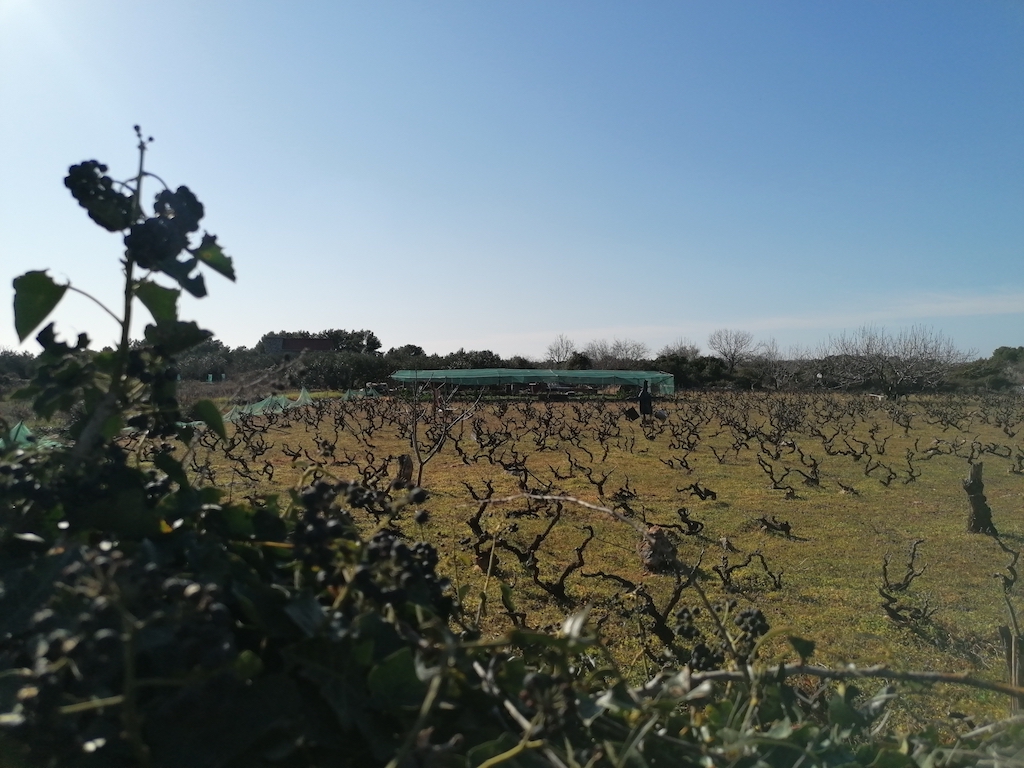
3. Don't be afraid to go around the island alone.
Saying goodbye, Milan wondered why I was here alone. "You don't have to go alone. Find yourself a husband. Not me, I'm too old for you, I'm over 72..."
I guess it was his joke about the age gap problem to marry me, because earlier he'd mentioned his wife was waiting for him at home, their three children, other common stuff.
Then he relented: "Well, all right, you can go alone. Don't be afraid. There are no poisonous snakes on the three Dalmatian islands - Solta, Lastovo, and Vis islands. But there are black widow spiders and ticks..."
As planned, I went through Grohote and Gornje Selo to Stomorska that I considered the most beautiful and lively town on the island. Besides, I was caught up in wanting to check a remark of my Croatian colleague that Stomorska on Solta looks similar to Povlja on Brac. He said it to me once I just got back from Brac. He really encouraged me, thus I'm not going to share if it looks similar or not. Go and check it by yourself!

I went through almost all the island - from Rogac to Stomorska - by foot. It was a safe and quiet way, not a lot of cars passed me. For sure, it'd be more convenient to go by bicycle, but if you have the time it's possible on foot. On my way back I accepted a proposal of one passing car to take me to the port. I guess you can also have this possibility in mind. As far as there are no regular buses, it's a kind of local solidary to take somebody by car.
One difficulty I faced in Stomorska was the fact that all the cafes and restaurants were closed. I came before the beginning of the tourist season and caught the middle of constructing and cleaning works around terraces, but it was closed. We might endlessly watch water, fire, and other people working, but not on an empty stomach.
4. If something goes wrong, you can always sleep on the beach.
I didn't plan on going to Solta a second time. I have already visited the largest and most beautiful town of Stomorska. I met a wonderful grandpa Milan who told me that Split needs a mayor like the Russian president and that our bodies are just food for aliens secretly dealing with the government. What else is needed?
Then my Split friend Andrea tried to convince me that the most beautiful place on the island is Maslinica, not Stomorska. Andrea knows it for sure, because her aunt lives in Maslinica, and she's there every summer.
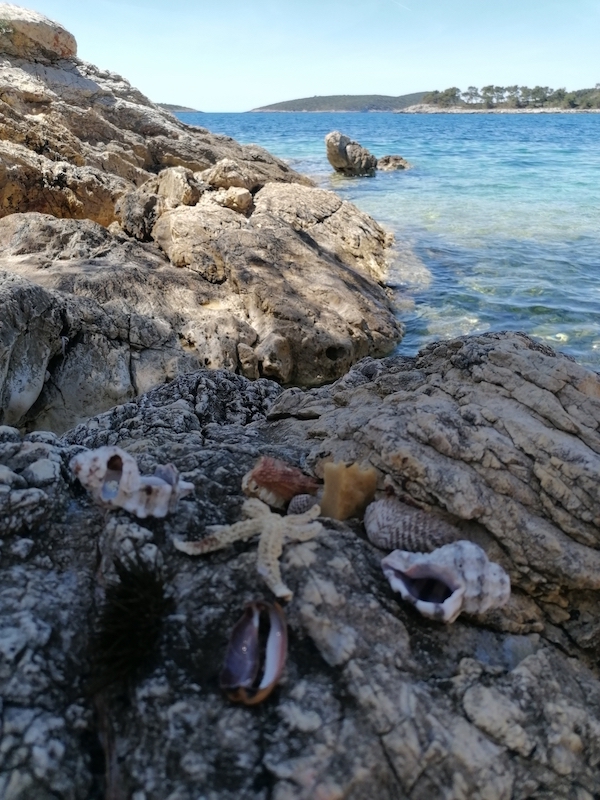
However, I still couldn't decide whether to go - to Brac or Solta - for Saturday sunbathing. At the last moment, I blurted out "Solta" at the checkout. "On the first ferry, please!" I totally forgot that the first ferry is at 6:40 am. "Nevermind, I'll go to sleep earlier today!" Then I recognised this ticket purchase was a fundamentally wrong decision. That Friday we celebrated Sveti Duje, the day of the saint patron of Split. There was no chance for me to escape the celebration and go to sleep earlier.
A suddenly emerged thought saved me from the desire to throw the ferry ticket into the sea from the pier where we celebrated Split City Day in the middle of an incredible post-covid standard crowd until 2:00 am. I thought that I could sleep on the beach of Maslinica on Solta. After 3.5 hours of sleep at home, I packed up and ran to the ferry.
5. Sometimes it is helpful to talk to a homeless man.
Solta is the closest island to Split. By ferry, one way takes only one hour. Once I'd settled on the ferry, I fell asleep. Thank you to the kind Croatian woman next to me who woke me up! At the port of Rogac I checked Google maps - 2 hours walk to Maslinica. 20 minutes later I reached one of the three 'towns' of Solta where you can find a supermarket.
Entering the supermarket I noticed a very colorful homeless man on the bench in front of it. He looked like Ali Baba. Red down jacket, harem pants, white apron, blue hoodie tied around the neck instead of a scarf. Fingerless gloves. A black beret holding a tuft of long gray hair and a gray beard. I had to restrain myself from taking a picture of him. I was not going to sponsor his vodka.
I had to restrain myself, but failed at the checkout. Too good a type! He was standing on the other side of the glass door while he noticed me taking a picture of him. He was waiting for me at the exit. "Take an initiative talking with locals. Don't be afraid!" I calmed myself. "Please, sir, may I take a picture of you?"

On the fifth attempt, the homeless man guessed that I was from Russia. Novorossiysk (Russian port) - Izmail (today's Ukraine) - Gori (Georgia). That's in general how his path in USSR looked like. His work had something to do with the sea as I understood. "I had a great company in the Crimea," he said. "I still remember those five Russian women surrounding me: Lyuba, Zoya, Nina..." It seems to be true, in those days the names were popular in the Soviet Union. The man was in Poland as well, in the Czech Republic. He worked in France for six months, then in the United States...
He remembered a few sentences in Russian. Here on the island, there were some Russian girls in Necujem. He taught them three main phrases in Croatian:
- Mi se svije Hrvatska. (I like Croatia).
- Ja ću se udati za Dalmatinca. (I will marry a Dalmatian man).
- Ja sam dobra pička. (I'm a good p***y).
Well, I can trace some logical connection here...
6. Have a list of souvenirs from Solta.
Homeless Ali Baba asked me how long would I stay in Croatia. He began to think about what souvenirs should I send to my family in Russia. Solta olive oil, Solta honey, Solta wine, Rogac bean for baking, lavender...
"I will collect it for the next time you come to Solta. I have oil, wine, a farm, 7 chickens, 2 houses... You can sleep in one of them, and I'll stay in the other. Is it okay? Take some lavender I picked this morning. Here you are. Do you know that there are two types of lavender? Do you want a chocolate bar?"
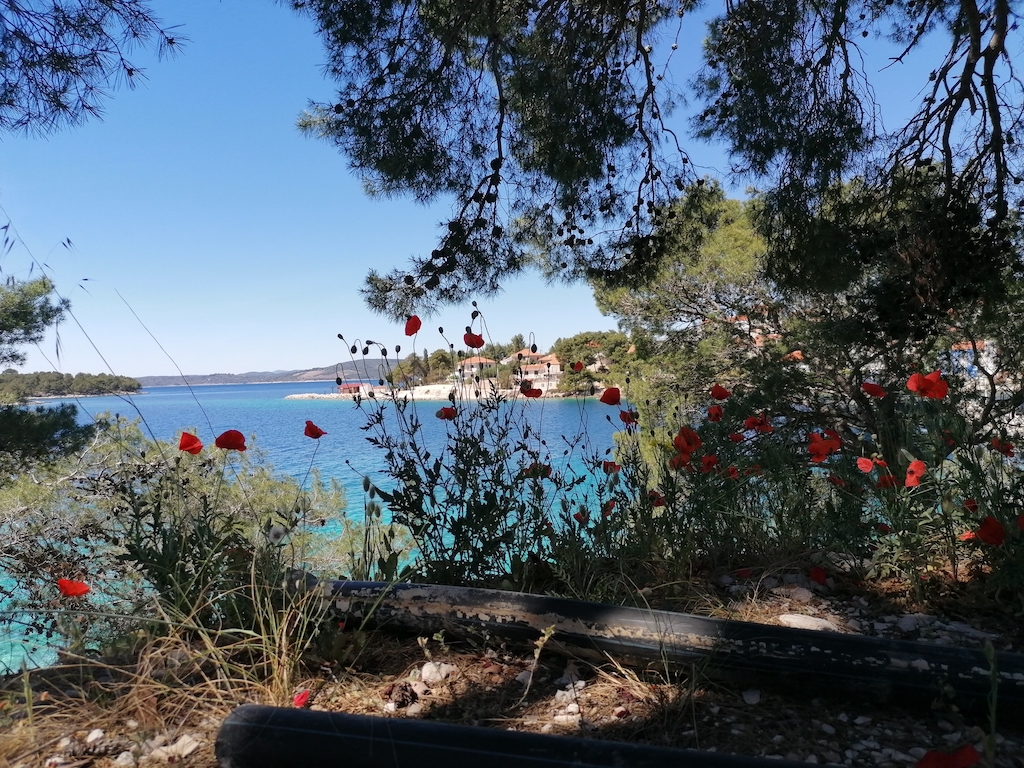
I jumped aside as Ali Baba touched me with lavender. Flowers do not excuse the whole stench. And the worst thing was his long nails. I was at a loss. Some parts of his story seemed plausible. However, I could not find any logical connection between his own farm and the homeless look. Two houses? I'm not going to believe in it.
The situation that we were standing in the center of the town nearby the only supermarket seemed even stranger. People passed us by us every five minutes. They greeted Ali, in response he defiantly showed me to everyone. "Look, such a beautiful Russian is talking to me!" Passersby looked at me with a grain of compassion, but they passed by further. Then one of the passers-by had heard that I was on my way to Maslinica and offered to give me a ride. He was going in the same direction. Thank you, Igore! I quickly got in the car.
Recap
1. Clothes do not make the man.
In the end, I got to Maslinica in 15 minutes by car, not in 2 hours by foot. On the way, Igor explained to me that Marin Kumin (that's the true name of 'Ali Baba') was not homeless. He does have things he mentioned. He's not a foolish man. Unfortunately, he went crazy in the sea about two years ago. Since then he has not been washing, shaving, cutting his hair. It looks scary from the outside. But he's not what he seems to be.

2. Take the initiative to talk to locals on the island.
I would probably consider the breakfast that Igor fed me after we came to Maslinica - coffee and toast with Solta honey - as a part of traditional Dalmatian hospitality. But the best lunch I've had in Dalmatia would never happen if I had left his place in a rush, without any conversation. I asked about a fishery on the island - I had lunch with Igor and his friends-fishermen. We ate the tuna they caught the day before. I had only known about tuna from canned food and Hemingway's story 'The Old Man and the Sea'. My concepts were turned upside down. Eventually, I found an island where there's more fish than meat.
3. Don't be afraid to go around the island alone.
Igor showed me the Maslinica neighborhood, Martinis-Marchi castle, and a way to a beach. Then I went alone to an empty rocky beach. I swam also alone, although there were some yachts around. No fear. I was a little worried that nobody will notice if I drown. But as I got out the beach marine officers asked me about the temperature of the water and how I felt.
4. If something goes wrong, you can always sleep on the beach.
It was my first swimming this year. The water at the beginning of May was still cold. I swam for five minutes. Never mind, then I slept on the beach. And then I swam two more times.
5. Sometimes it is helpful to talk to a homeless man.
I mean a keen conversation, lavender and the fresh tuna I had!
6. Have a list of souvenirs from Solta.
Try to do it in advance, because when you come outside the tourist season, it's complicated to get the souvenirs immediately. I didn't succeed to take a bottle of Solta olive oil on the same day, so I had to go back again.
For more on travel in Croatia, follow TCN's dedicated page.
24 Billion HRK Invested In Islands In The Past 14 Years
ZAGREB, 3 March, 2021 - In the past 14 years almost HRK 24 billion has been invested in Croatia's islands, an average of HRK 1.7 billion a year, a government representative said in parliament on Wednesday, reporting on the implementation of the Islands Act in 2018 and 2019.
MP Anka Mrak Taritaš of the opposition GLAS said a debate on the report was an opportunity to talk about how to keep people on the islands and how much was invested in renewables, environmental protection and waste management.
Croatia systematically caring for islands
MPs of the ruling HDZ said Croatia was systematically caring for its islands, including through investments, absorbing EU funds, renewing the fleet and dealing with waste management.
Mirela Ahmetović of the opposition Social Democratic Party said the increase in investment in the islands was not only a result of the law but also thanks to efficient local government.
She criticised Croatian Post for investing only HRK 430,000 in islands, despite record profits, for the procurement of air conditioning units.
Sandra Benčić of the opposition green-left bloc underlined the importance of investing in quality education.
Number of island residents up by almost 5,000
In 2018, the population of 51 island local units went up by 4,903 from 2011 and in that period 36 island towns and municipalities recorded positive trends, said Spomenka Đurić, state secretary at the Regional Development Ministry.
She said investments in the islands increased every year because the state recognised them as areas of special interest and big potential.
The absorption of EU funds through strategic projects significantly contribute to investments, from HRK 530 million in 2017 to HRK 1.4 billion in 2019, Đurić added.
Speaking of key strategic projects, she mentioned Pelješac Bridge, island ports and water supply.
Đurić said 45 islands are permanently or temporarily inhabited, with 51 maritime routes, 58 community health centres, 102 primary and 13 high schools, and 23 care homes.
(€1 = HRK 7.5)
Circular Economy on Islands Lags Due to Low Environmental Awareness
February 17, 2021 – In a video podcast entitled "Energy Transition on the Islands," organized by the Island Movement initiative, participants warned that underdeveloped environmental awareness is one of the main obstacles to implementing the circular economy on islands.
As Hina reports, the deputy mayors of Hvar and Cres warned that citizens are still unaware of the green economy's importance, which makes it challenging to introduce a circular economy on islands.
"The most difficult phase in achieving sustainable development is to explain to ordinary citizens why the energy transition would be a step forward," said Marin Gregorović, deputy mayor of Cres.
The circular economy is a production and consumption model that encourages sharing, borrowing, reuse, repair, recovering, and recycling of products and materials to achieve the product's added value. Such a concept has a positive effect on reducing the amount of waste.
Commenting on the inefficient disposal of waste on the islands, Gregorović noted that "the system is not working well" and that "we have not yet reached the stage of resolving the issue of biowaste disposal."
"Although we have a recycling yard and dual waste management on Cres, and we plan to build a composting plant, the story of the circular economy is still just – a story," said Gregorović.
Kuzman Novak, deputy mayor of Hvar town, added that "the fundamental problem at the national level is waste management."
"We take the garbage bags out of the house, and they are taken away, which we don't see, so we don't think they are our concern anymore. That is the key problem," Novak said, explaining the underdeveloped environmental awareness of citizens.
"When we talk about sustainable development, it's not just about solar power plants and waste management, it's essentially developing an awareness not to be selfish," said Novak.
The new EU Action Plan for the Circular Economy is one of the key elements in achieving climate neutrality, which is a central goal of the European Green Plan. Voting on the new EU circular economy action plan, the European Parliament this month called for additional measures to achieve a carbon-neutral, environmentally sustainable, and fully circular economy by 2050.
To read more about lifestyle in Croatia, follow TCN's dedicated page.
Croatian Islanders Can Now Apply for Island Cards Through E-Citizens System
As Morski writes on the 13th of April, 2020, the Coastal Shipping Agency would like to inform Croatian islanders that they can apply for an island card (otocna iskaznica) through the e-Citizens system, which has grown in popularity ever since the coronavirus crisis struck, making a digital Croatia a reality much sooner than the powers that be would have us believe was possible.
The electronic island card application service for Croatian islanders is available via this link and on the official website of the Coastal Shipping Agency. The service will also be accessible directly through the e-Citizens portal upon selecting a service from the transport and vehicles category.
Users, more specifically Croatian islanders, will be able to apply for their island cards for a person or for a vehicle electronically, and will be informed via the e-Citizens platform about the status of their respective applications.
To successfully process an application when it is completed online, a payment must be made to the state for the issuance of the island card (65 kuna for the issuance of an island card for a person and 80 kuna for the issuance of a card for a vehicle) as well as a scanned photo for a personal document (dimension 35mmX45mm) in the case of an application for an island ID card for a person.
The completed and valid island card will then be delivered to Croatian islanders at the post office of their own choice, which they must make clear at the time of their initial application, and within twenty days from the date of approval of the request.
Requests will can still be made at the post offices listed here.
For technical support or if you need to report a problem, users can contact the contact telephone number: 0800 0440 (contact centre opening hours: Mon-Fri from 08:00-16:00) or by email: This email address is being protected from spambots. You need JavaScript enabled to view it..
Make sure to follow our dedicated coronavirus section for all you need to know about the pandemic in relation to Croatia. For more on travel, follow this page.


